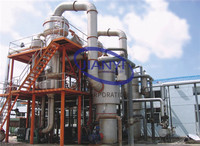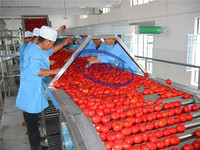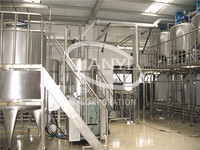Complete Pasteurized Milk machine Production Line
Specifications
Description of this pasteurized milk production line :
Pasteurized milk is milk which has been heat-treated to kill pathogens which cause disease. Not all pathogens are removed during the pasteurization process, so pasteurized milk is not 100% sterile,
but many people consider it to be safer to drink than raw milk which has not been pasteurized at all. The bulk of the milk sold in commercial grocery stores is pasteurized, and much of it is also
homogenized to prevent the cream from separating.
First the milk is preheated andstandardised by in line milk fat standardisation system. The purpose ofstandardisation is to give the milk a defined, guaranteed fat content. Commonvalues are 1.5%
for low fat milk and 3% for regular grade milk, fat contents aslow as 0.1 and 0.5 % is skimmilk.
Then the standardised milk ishomogenised. The purpose of homogenisation is to disintegrate or finelydistribute the fat globules in the milk in order to reduce creaming.Homogenisation may be total
or partial. Partial homogenisation is a moreeconomical solution, because a smaller homogeniser can be used.
The milk, now ispumped to the heating section of the milk heat exchanger where it ispasteurised. The necessary holding time is provided by a separate holding tube.The pasteurisation temperature is
recorded continuously. Pump is a booster pumpwhich increases the pressure of the product to a level at which the pasteurisedproduct cannot be contaminated by untreated milk or by the cooling medium
if aleak occur in the plate heat exchanger. If the pasteurisation temperatureshould drop, this is sensed by a temperature transmitter. A signal activatesflow diversion valve and the milk flows back
to the balance tank. Afterpasteurisation the milk continues to a cooling section in the heat exchanger,where it is regeneratively cooled by the incoming untreated cold milk, and thento the cooling
section where it is cooled with ice water. The cold milk is thenpumped to the filling machines.
Temperature and pasteurisation holding time are very important factors which mustbe specified precisely in relation to the quality of the milk and its shelflife requirements. The pasteurisation
temperature is usually 72 – 75C for 15 –20 sec. A common requirement is that the heat treatment must guarantee thedestruction of unwanted microorganisms and of all pathogenic bacteria withoutthe
product being damaged.
- Country: China (Mainland)
- Market: Africa,Asia,Americas,Emerging Markets,Europe,G20,European Union,Middle East,Oceania
- Founded Year: 2007
- Address: No. 58-1, Xingpu Road, Lujia Town, Kunshan City
- Contact: Ms. Daisy










